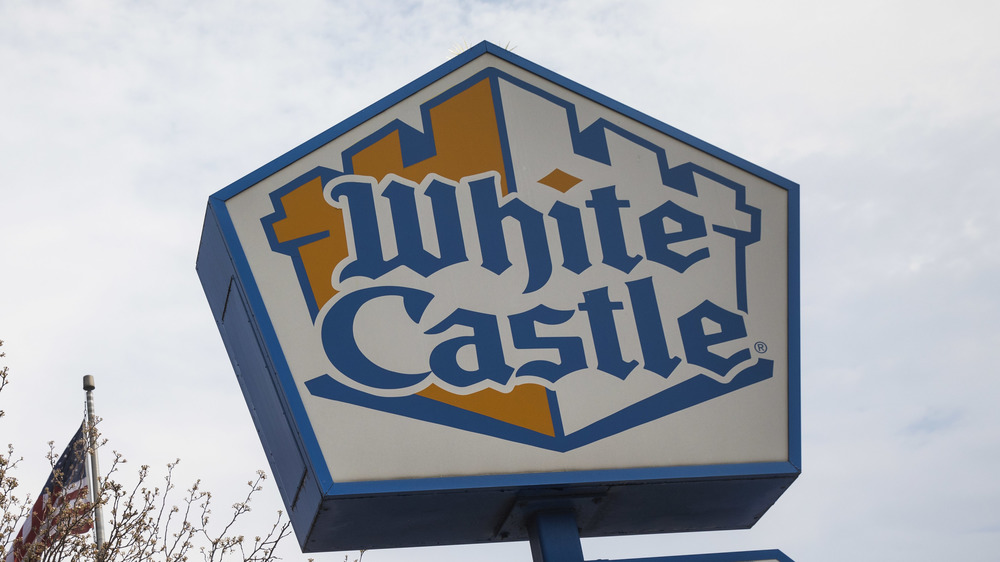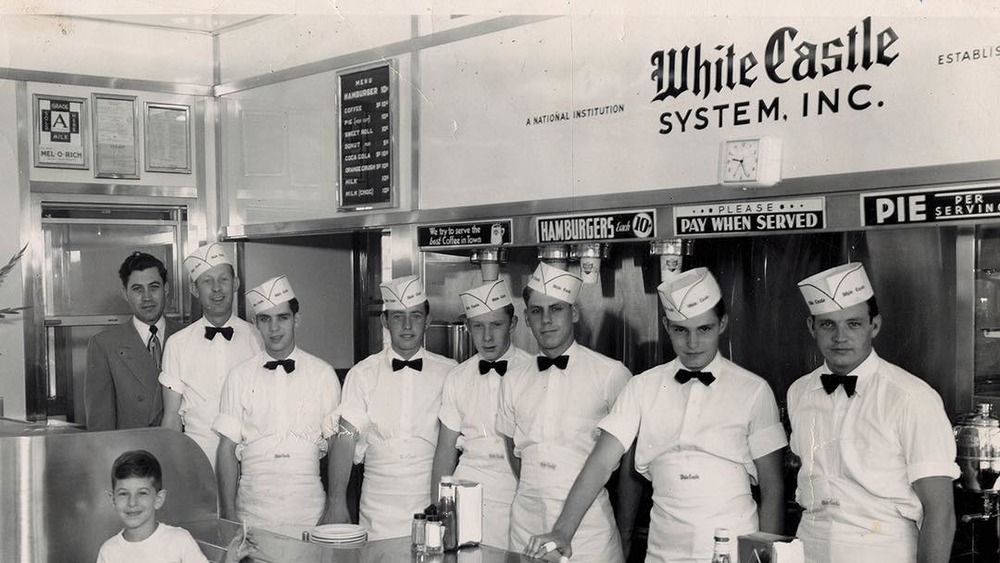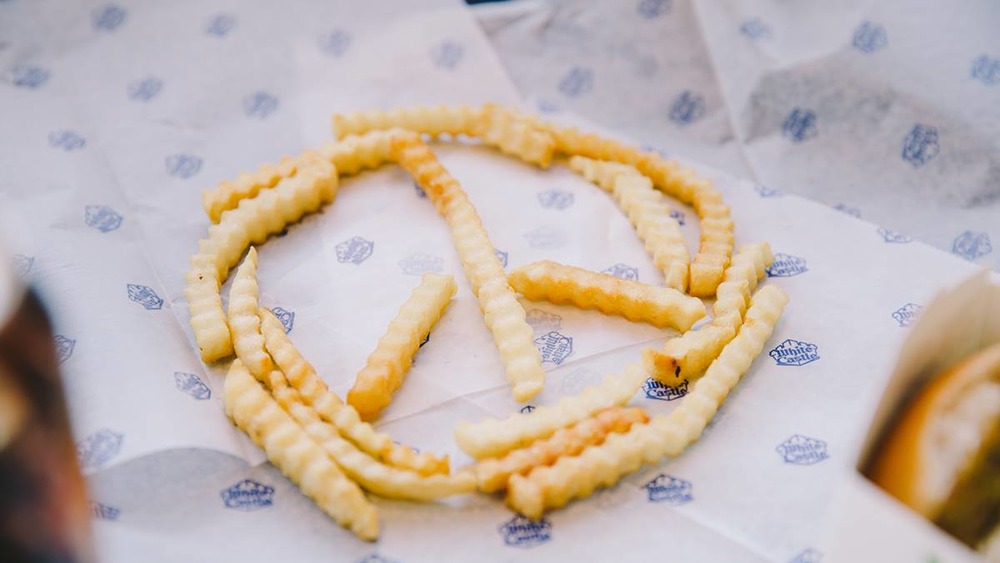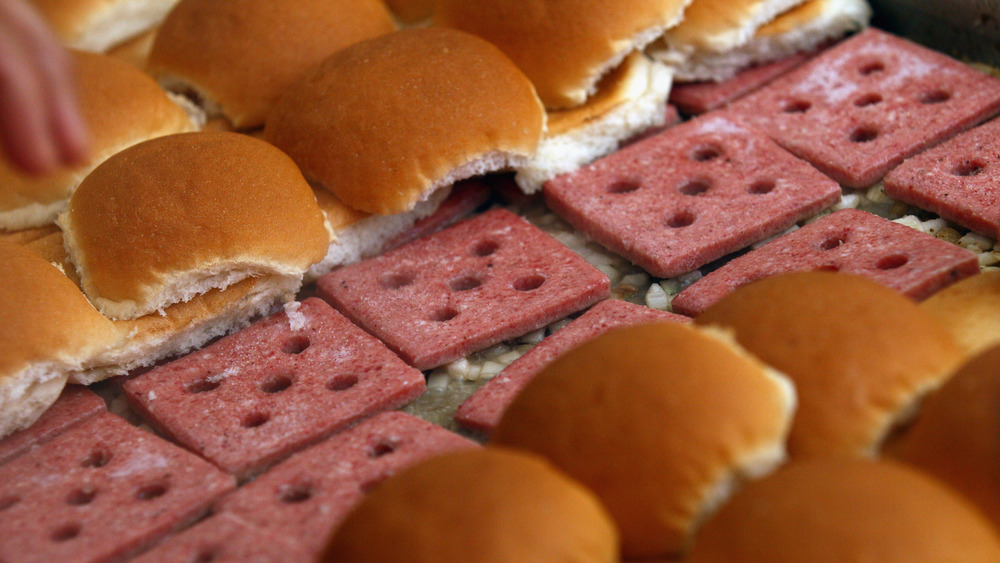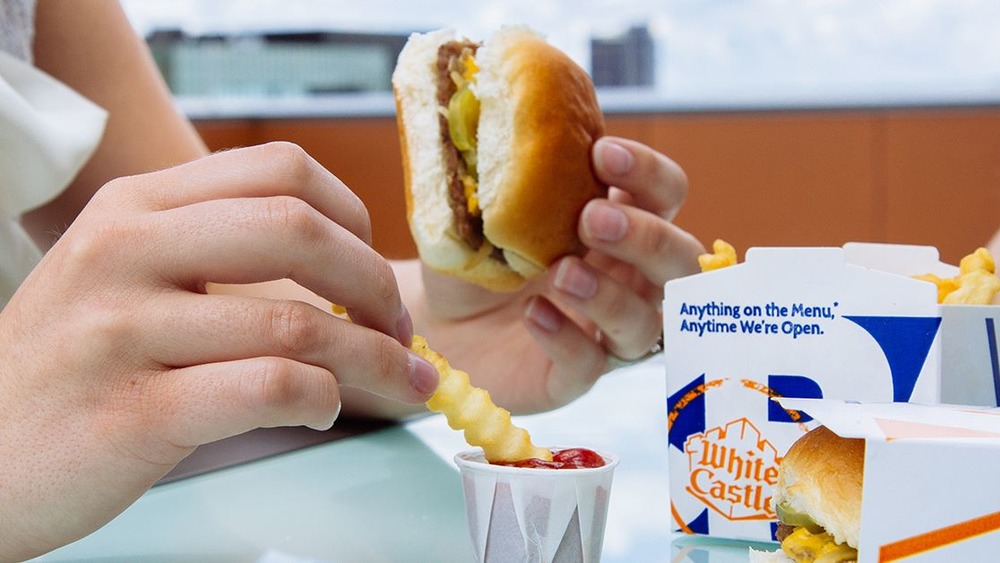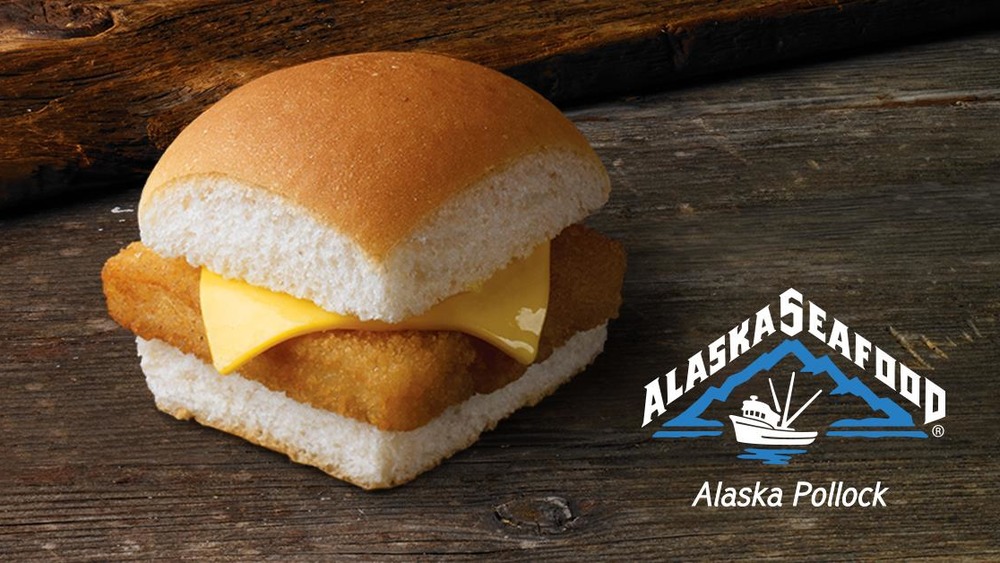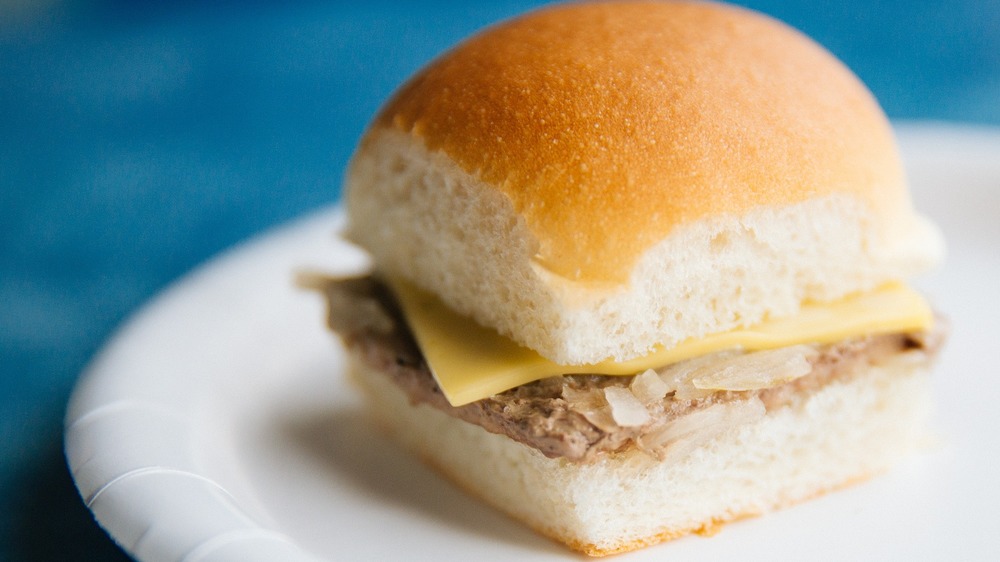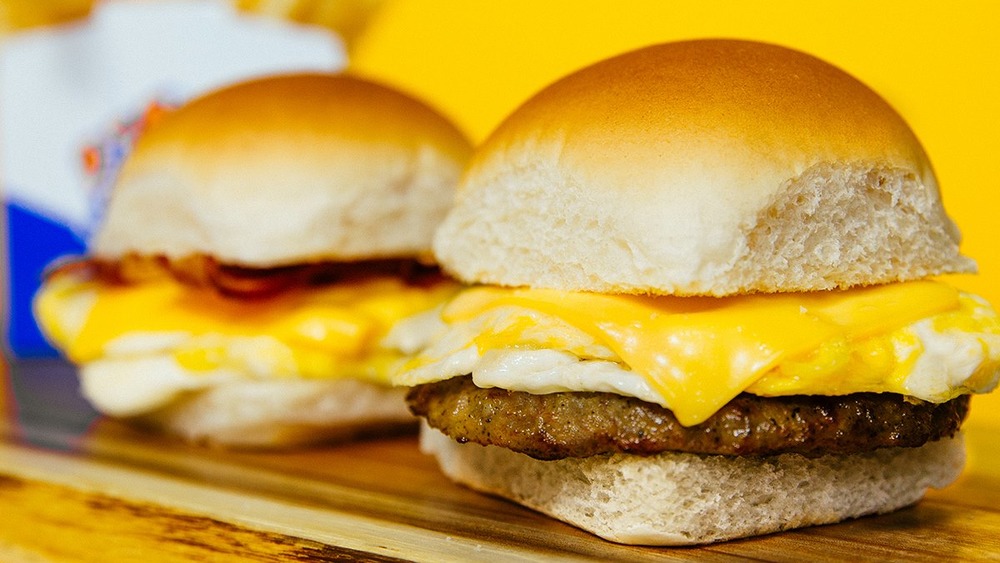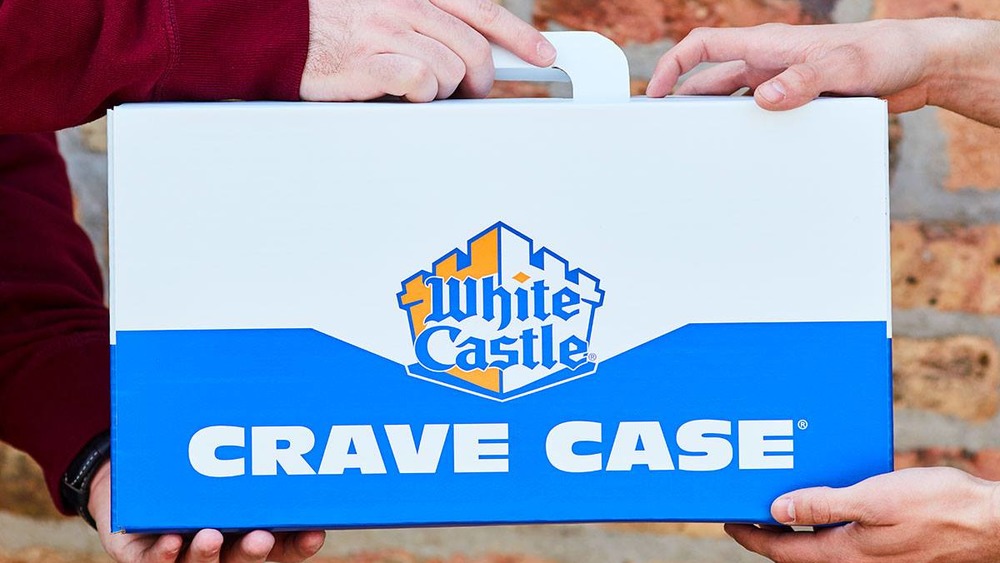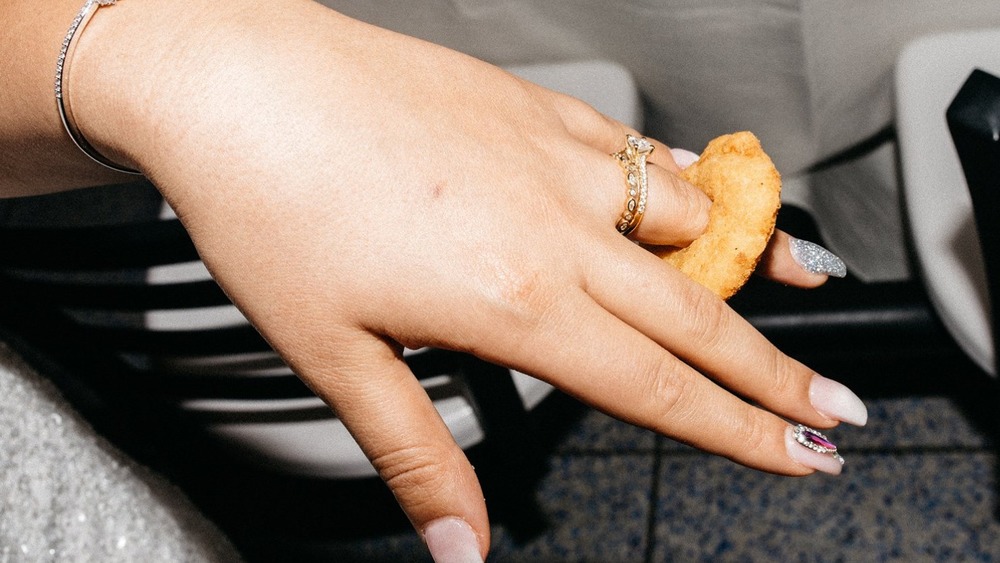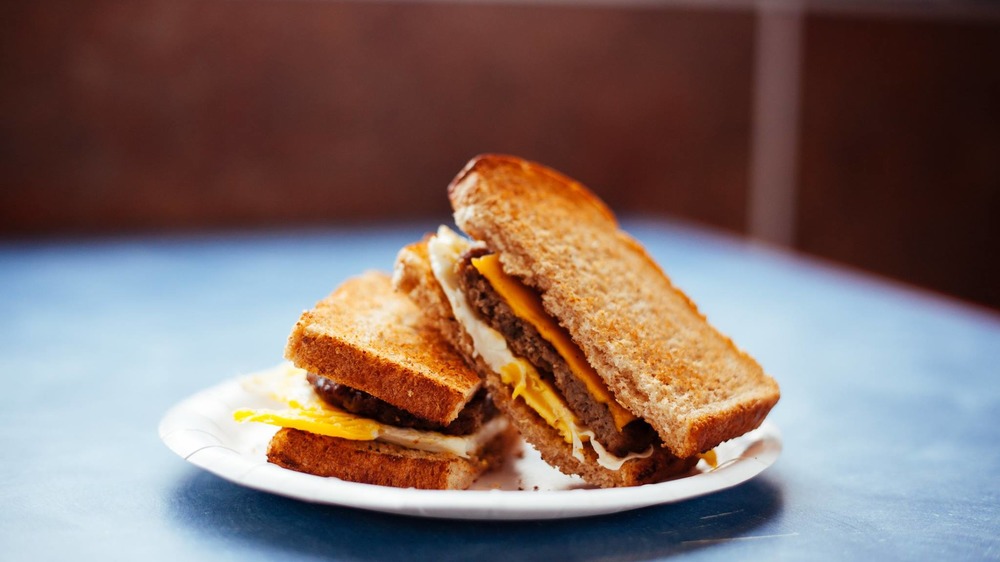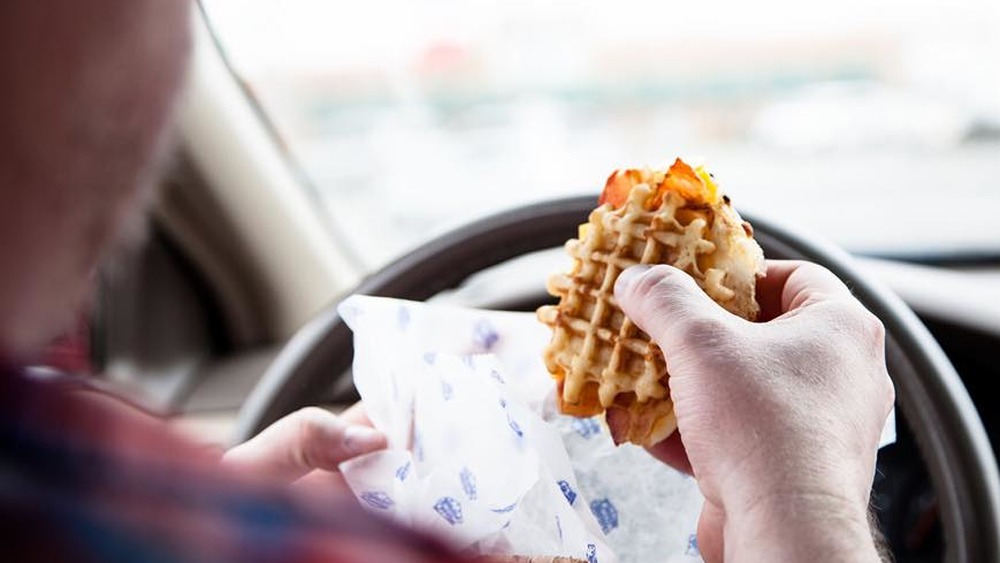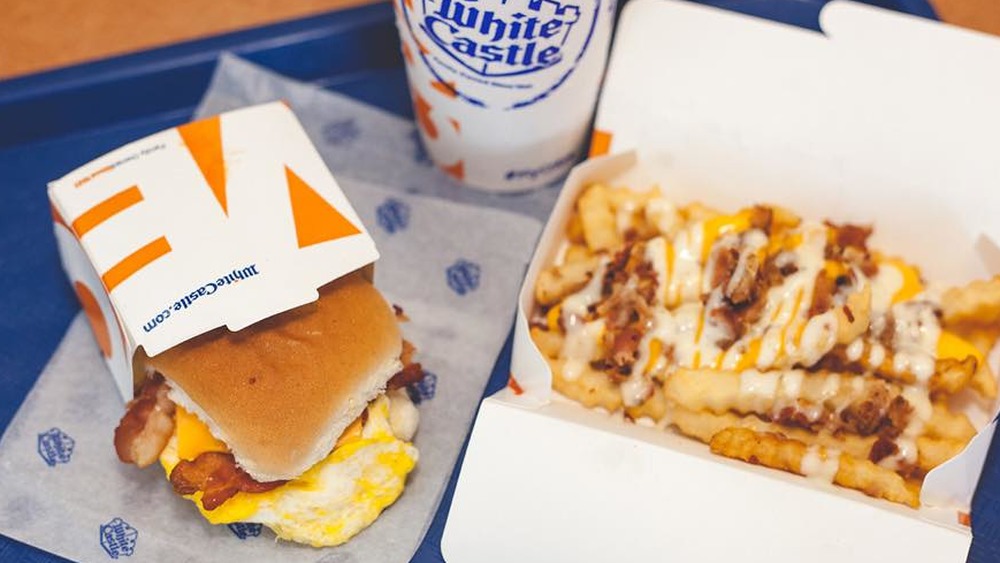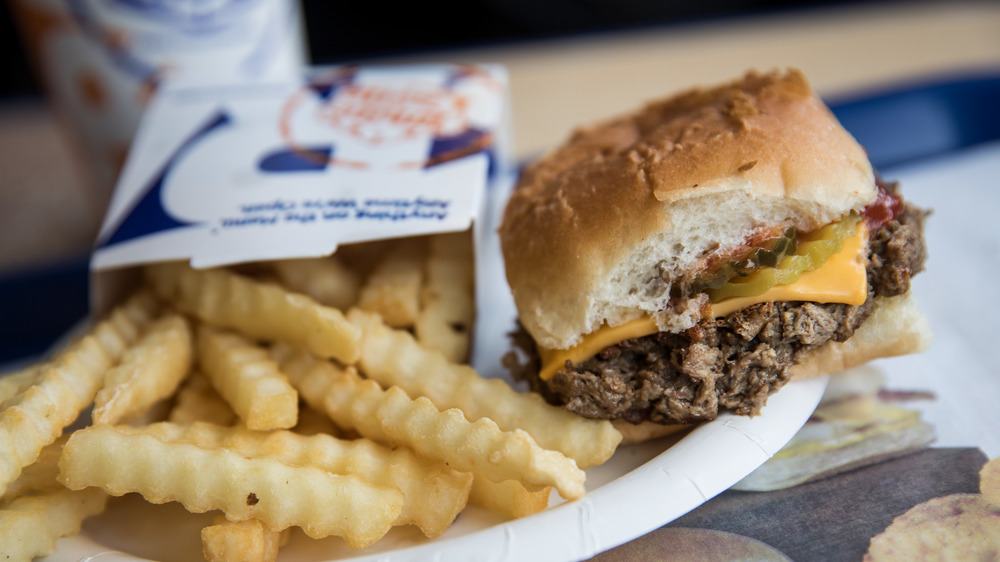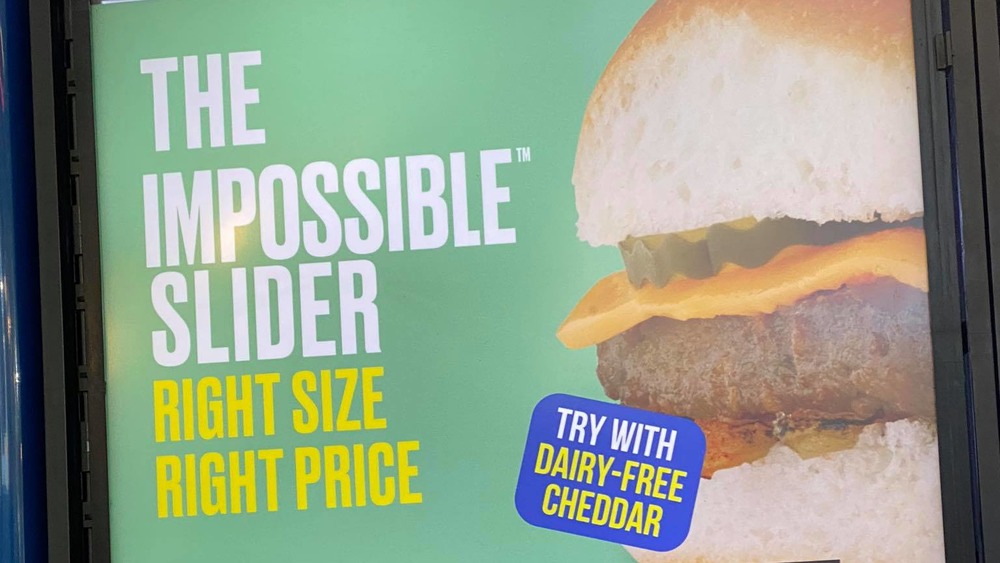What White Castle's Menu Looked Like The Year You Were Born
Mention fast-food sliders and everyone most likely thinks of one place: White Castle. The iconic small burgers topped with onions and a pickle, all found at White Castle restaurant chains modeled after the historic Chicago Water Tower building, changed the way Americans viewed hamburgers. White Castle, which opened in 1921 and claims to be the first fast-food hamburger chain in the world, launched an industry that would change food for good.
Still, even though everyone knows White Castle and the chain's longevity is nothing to scoff at, White Castle isn't terribly prominent. The restaurant has a relatively small 599 locations, all in a limited region of the United States. You can find most White Castles clustered in the Midwest. So, what made White Castle a household name, despite the chain's small size? While Harold and Kumar probably have a bit to do with it, you can also chalk up White Castle's success to its dedication to simplicity and focus.
According to The Columbus Dispatch, the brand has kept things small on purpose, both in terms of the number of its locations and the chain's menu size. The White Castle menu has remained the same for decades at a time throughout the chain's 100-year history, with just about every menu change carefully weighed, considered, and perfected before its release. Here are a few of those most impactful moments in White Castle menu history that happened the year you were born.
1921–1942: White Castle sets out to change the face of an industry
White Castle opened up its first location in Wichita, Kansas in 1921 (via Time). The idea was to create a restaurant where diners could enjoy the then-unfamiliar wonder of the burger and also enjoy a spotless atmosphere and quick and polite service. White Castle hoped to change the reputation of ground beef, which was at the time extremely poor. That reputation was entrenched by works like Upton Sinclair's The Jungle, a 1906 novel that depicted the beef industry as highly unsanitary.
Upon opening, the first White Castle menu was exceptionally simple with only four items. As White Castle claimed in a 2016 press release, this allowed for greater quality control. Those delicious White Castle sliders were the only entree available, with Coca-Cola and coffee to drink and apple pie for dessert. According to Fast Food and Junk Food, the tiny burger patties were made small in order to speed up the cooking process and seal in the meat's natural juices. Though the vintage patties looked relatively familiar to White Castle's sliders of today, there were a few key differences. Back then, the raw patty was cooked directly on a grill and flipped, as opposed to today's steam and set method (via AZCentral). The sliders were then topped with diced onions, salt, and pepper, and then came on a bun and in a sack. Diners also had the option of adding other toppings, such as pickles, cheese, lettuce, and tomato.
1943–1946: World War II results in big changes for the White Castle menu
White Castle did well throughout the Great Depression, reports the Whiting-Robertsdale Historical Society, growing its number of restaurants to more than 100 and inspiring knock-off brands to follow their lead. Unfortunately, World War II presented serious challenges to the chain. Sliders, Coke, and coffee made up more than half of White Castle's menu at the time, but when the U.S. Government began rationing sugar, coffee, and meat during the war, it became difficult to maintain the old menu.
White Castle turned to other menu items to pick up the slack. In addition to sliders, customers could also order fried egg sandwiches, hot dogs, grilled cheese sandwiches, and baked beans, a Depression-era favorite dish. White Castle also offered french fries for the first time. As for the sliders, they also received a slight change due to an onion shortage. Rather than use fresh onions on the burgers, White Castle began using more widely available dehydrated onions. While White Castle dropped all the other menu changes (including the fries) after the war, it kept the dehydrated onions.
1947–1950: Better White Castle burgers for a lower cost
Once World War II was over and servicemen came back to their jobs, White Castle was not quite out of its difficult years. Food shortages were still an issue, as was finding employees. During this time, Thrillist reports, one innovative White Castle operator in Cincinnati named Earl Howell made a big change to the way his location made its sliders. The result was a better burger for a lower cost.
In order to get more sliders from a single pound of beef, the operator cut down the size of the sandwiches and then drilled five holes into each patty. Not only did this save cash, but it enhanced each burger's flavor, as the patty's juices were better retained and it made the burger cook faster. It also meant shorter wait times for hungry customers. White Castle patented the concept once it was clear that the method was bound to win from every angle.
Around the same time, White Castle also switched from cooking its patties directly on the grill and then topping them with onions, to piling up the onions on the grill first and then layering the patties atop the onions. This resulted in a steamier cooking method still in use today.
1951–1952: Competition heats up between White Castle and other fast-food joints
By the 1950s, White Castle was certainly not the only major fast-food player on the scene. Other chains were quickly building steam and soon McDonald's and Burger King would both take off (via Business Insider). Other competitors included Steak n' Shake, Howard Johnson's, and Bob's Big Boy, according to the Whiting-Robertsdale Historical Society. One thing that set these competitors apart and gave them a potential edge over White Castle? They all believed in franchising, something White Castle still refuses to do.
White Castle owners realized that they needed to stay ahead of the curve. So, they decided to expand the chain's stalwart menu in ways only previously done out of sheer necessity. White Castle looked to previous successes from World War II for inspiration and found french fries, which it added back to the menu. The chain also tried out milkshakes for the first time. The two menu changes were successful. You can still find both of these menu items at White Castle today.
1953–1961: White Castle adds fish to the menu
Most know the story of McDonald's Filet o' Fish and how it was added to the menu as an effort to attract Catholic customers who could not eat meat on Fridays, according to Thrillist. However, McDonald's was not the first to come up with this concept by the time the fast-food giant introduced the sandwich in the early 1960s.
Instead, White Castle was at the forefront of the fast-food fish sandwich trend, offering it in an effort to attract Catholic customers during the Korean War. The fish sandwiches were only available on Fridays, but they proved relatively successful. However, White Castle reports that it did not make them a permanent menu item at the time. Today, however, you can get a White Castle fish slider, with a breaded fish patty, tartar sauce, and cheese served on the same steamed buns that are used for the regular sliders.
By the early 1960s, White Castle was still having success with its very limited menu and, in 1961, the chain sold its billionth burger (via Mental Floss).
1962–1985: White Castle takes its new menu change seriously
When White Castle makes a menu change, it doesn't fool around. The brand takes things very seriously, as evidenced by how slowly the menu has changed over the years. In 1962, White Castle would make its very first, new, permanent entree menu addition that was not as a result of war shortages. Then, it would put a halt on adding anything else permanent and new for the next two decades.
The big change? White Castle released the White Castle cheeseburger. Appearing 41 years after the original White Castle slider burger, the cheeseburger was an exact replica of the regular slider, with its onions and pickles, only with the addition of a miniature slice of cheese. The menu addition was a success and the cheeseburger remained. White Castle sat on its laurels until the mid-1980s when it would branch out into new territory in order to keep up with the fast-food times: breakfast.
1986–1987: White Castle does its breakfast menu the right way
In 1986, White Castle decided to head into the world of fast-food breakfast. As such, it was quickly decided that, according to Spoon University, all of its offerings would be made to order, using only freshly cracked eggs unlike the liquid and frozen egg business that you find at other fast-food chains. According to a 2015 press release, White Castle's first breakfast sandwich was a breakfast slider with egg and cheese, along with the customer's choice of sausage or bacon, all served on the same steamed bun that you get with a regular slider. The sandwich would be the lone breakfast menu item until 2011, when White Castle launched a toast sandwich.
The menu change came right around the time that White Castle was experiencing some other overall, larger changes for the brand, such as the launch of its frozen line of hamburgers in 1987 and its introduction of drive-thru's in 1980.
1988–2000: White Castle add a menu for kids
By the late 1980s, White Castle had begun testing out new menu items on a small scale partially in thanks to new leadership that, as per The New York Times, included E.W. Ingram III, the co-founder's grandson. Tested menu items included chicken nuggets and double burgers, which, in the vein of the McDonald's Big Mac, takes two patties and wedges a third layer of bread between them, in addition to the top and bottom bun, with extra toppings to go along with the extra patty.
However, White Castle realized that its customer base was aging. White Castle wasn't attracting a younger audience. In an effort to attract a new generation, White Castle introduced its kids' meal, the Castle Meal. This new menu item came with one slider, fries, a drink, and a prize, all in a cardboard castle. The effort increased sales with both kids and parents.
2001: White Castle embraces the crave
While the 1990s were quiet for White Castle, the next two decades would present an ever-growing menu and rotating door of seasonal and promotional items. It all started in 2001, when White Castle introduced its Crave Case, a case of 30 sliders. In 2001, White Castle introduced its Cravers Hall of Fame and inducted its inaugural class of Cravers. According to Food & Beverage Magazine, some of these famous White Castle Cravers included Alice Cooper, Stan Lee, and, of course, John Cho and Kal Penn, stars of the cult hit, Harold & Kumar Go to White Castle.
Over the years, the Crave Case experience has evolved, such as when White Castle launched Crave Copters to deliver Crave Cases via drone. In 2020, White Castle realized that not everyone necessarily needs 30 sliders at once, and so introduced the Crave Clutch, with 20 sliders in a box.
2002: White Castle adds chicken rings to its menu
Why have chicken nuggets, chicken strips, or even chicken fries, when you can have chicken rings? In 2002, White Castle changed up the chicken game with the introduction of this rather untraditional fast-food item. It was a great success, as White Castle chicken rings now have something of a cult following. In an effort to compete against chicken options at other fast-food restaurants, the chicken rings were available two ways: as a slider (two chicken rings on one bun and topped with the cheese of your choice) or as a side. Variations of the chicken rings over the years have included flavored and pretzel-coated chicken rings, but the OG rings remain a reliable menu item at White Castle, much to Cravers' delight. Some have even gone so far as to propose using chicken rings or have exchanged chicken rings at their weddings.
2011: White Castle finally goes big with its breakfast menu
In 2011, White Castle finally expanded its breakfast menu with the introduction of a new egg and toast sandwich. The debut menu item went beyond the simple breakfast slider with its egg, cheese, and bacon, while still holding true to its values and focus on high-quality and freshly cracked eggs. But the White Castle egg and toast sandwich wasn't just unique in that it was a new breakfast menu item. Its uniqueness also lies in the fact that the egg and toast sandwich is one of White Castle's only "normal"-sized items. Deviating away from its precious slider buns, White Castle introduced this sandwich with your standard toast, a fried egg, and your choice of bacon or sausage. Simple, easy, and with a decidedly nice crunch that the breakfast sliders lack, the toast sandwich was a hit. Now, you can enjoy this meal with a combo of two toast sandwiches, including a side of round, miniature hash browns and coffee.
2014: White Castle adds new ways to enjoy breakfast and lunch
In 2014, White Castle took breakfast to a whole other level, with Belgian Waffle breakfast sliders, something that was intended as a promotional item only, but which soon became a permanent part of the menu. What exactly is it? An imported Belgian waffle straight from Brussels, according to Food & Wine, as well as a fresh egg, cheese, and your choice of bacon or sausage. In addition to the OG Belgian Waffle breakfast sliders, White Castle has also offered a variety of other Belgian waffle-sandwiched menu items since, including a chicken and waffle slider, with a breaded chicken breast, bacon bits, and country gravy, that was considered part of the lunch/dinner menu, rather than a breakfast item.
Beyond breakfast, White Castle also made its first foray into the world of meat alternatives in 2014, with the introduction of its veggie slider. Featuring a Dr. Praeger's veggie burger made from vegetables such as carrots and spinach, the burgers were grilled and then placed on a slider bun, versus being cooked White Castle's usual way, and the burgers were topped with a choice of three sauces: honey mustard, ranch, or sweet Thai.
2015: White Castle cures your all-day cravings
With the hit of the Belgian Waffle Breakfast Slider on its hands, White Castle accounted in a 2015 press release that it had finally made the decision to go all-day with its breakfast. Previously, customers could only order breakfast items like Belgian Waffle Breakfast Sliders between certain hours. Calling the new all-day breakfast menu its Anything, Anytime menu, White Castle didn't offer its full breakfast options 24-7, but it did provide some of its most popular options, like its original slider with egg and cheese, a newer offering that featured a hamburger slider topped with egg, cheese, and onion, but sans pickle.
The decision wasn't necessarily groundbreaking on White Castle's part, however. The menu change came along with similar menu changes around the country, as when McDonald's began all-day breakfast the same year, according to USA Today. Still, compared to eateries like Burger King, Wendy's, and Taco Bell, White Castle's all-day breakfast makes it stand out from the pack.
2018: White Castle teams up with Impossible Foods for a veggie menu
As more and more restaurants began offering plant-based menu items, White Castle decided to take its offerings a step beyond its veggie burger. In 2018, it became the first fast-food chain to offer the plant-based Impossible Burger, the Impossible Slider. Made by Impossible Foods, CNBC noted that the burgers look, taste, and "bleed" like real meat. Each Impossible Slider was topped with smoked cheddar cheese, pickles, and onions. As much as vegetarians may have been interested, reviews of the new slider were uneven at best. One reviewer from Eater said the Impossible Slider worked well for what it was, but it still wasn't quite tasty. "Once you get past the salty cheese, sweet onions, and handsome char [...] you'll notice a grey interior that has the same uncomfortable springiness and chewiness as a McDonald's burger," Eater reported. The flavor included the taste of "caramelized maitake mushrooms, followed by textured salt water."
2020: White Castle goes vegan with a new menu
While reviews weren't always kind, the vegetarian Impossible Slider was certainly beloved by many, as White Castle's sales exceeded expectations (via CNBC). White Castle was still leaving out one group of consumers that fast-food restaurants have a knack for overlooking: vegans. That cheese topping the Impossible Slider was made out of dairy, after all.
So, what's the next step? Top a meat-free slider with dairy-free cheese, of course. White Castle became the first fast-food hamburger chain in the United States to offer a dairy-free alternative to cheddar cheese. According to Food & Wine, the offering is available in select markets.
Meanwhile, The Guardian reports that Burger King and KFC have had issues cooking their vegan products in the same area that they cook meat products. White Castle, however, is careful to avoid that sort of cross-contamination. "White Castle prepares the Impossible Slider on a different griddle than the other meat-based Slider products," a spokesperson told Food & Wine. "Of course, White Castle cannot make a 100% guarantee that there is never any contact, however, the process has been set up and adhered to so that the Impossible Slider can be prepared separately."
